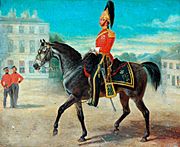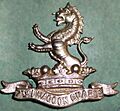7th Dragoon Guards facts for kids
Quick facts for kids 7th Dragoon Guards (Princess Royal's) |
|
|---|---|
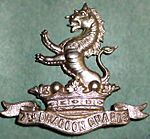
Regimental Badge
|
|
| Active | 1688–1922 |
| Country |
|
| Branch | British Army |
| Type | Cavalry |
| Role | Heavy Cavalry |
| Size | 550 |
| Nickname(s) | The Black Horse The Virgin Mary's Bodyguard |
| March | (slow) 7th (Princess Royal's) Dragoon Guards |
| Commanders | |
| Current commander |
Defunct |
The 7th (The Princess Royal's) Dragoon Guards was a special group of soldiers in the British Army. They were a type of cavalry regiment, which means they fought on horseback. This group was first started in 1688.
It was first known as Lord Cavendish's Regiment of Horse. Later, in 1788, it was renamed the 7th (The Princess Royal's) Dragoon Guards to honor Princess Charlotte. This regiment served for over 200 years, including during the First World War. In 1922, it joined with another group, the 4th Royal Irish Dragoon Guards, to form the 4th/7th Dragoon Guards.
Contents
- The Beginning: How the Regiment Started
- Early Battles and Adventures
- A Famous Leader: John Ligonier
- More Wars and a New Name
- Service Around the World
- The First World War and Beyond
- Where to Learn More: The Regimental Museum
- Special Honors: Battle Honours
- Remembering the Soldiers: Memorials
- Images for kids
- See also
The Beginning: How the Regiment Started
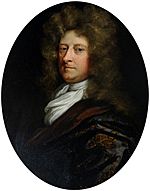
In 1688, there was a big change in England called the Glorious Revolution. During this time, William Cavendish gathered a group of horsemen. Their job was to protect Princess Anne, who was the daughter of King James II.
After King James II left the country, many small groups of horsemen came together. They formed one big group called Lord Cavendish's Regiment of Horse. This was the start of the 7th Dragoon Guards.
Early Battles and Adventures
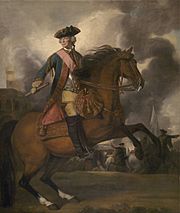
The regiment fought in many important battles. In July 1690, they fought in the Williamite War in Ireland at the Battle of the Boyne. After that, they moved to a place called Flanders in 1692. There, they took part in the Nine Years' War. They fought in a battle at Dottignies in 1693 and helped in the siege of Namur in 1695. The war ended in 1697.
The regiment was almost shut down, but it was saved by being sent to Ireland. They then served in Europe during the War of the Spanish Succession. They fought bravely in famous battles like Blenheim, Ramillies, and Malplaquet.
A Famous Leader: John Ligonier
After a peace treaty in 1713, the regiment returned to Ireland. In 1720, a very important leader named John Ligonier became their colonel. He was a French Huguenot who had come to England. He led the regiment for 29 years!
Under Ligonier, the regiment became known as one of the best and most skilled units in the British army. Many of its members were promoted for their brave actions in battle. Even in 1913, new soldiers were still taught about Ligonier. His personal symbol and motto were used by everyone in the regiment.
More Wars and a New Name
In 1742, the regiment went back to Flanders for the War of the Austrian Succession. They fought in the battles of Dettingen and Fontenoy. In July 1747, at the Battle of Lauffeld, Ligonier led a famous charge. This brave action helped their foot soldiers escape a difficult situation.
After another peace treaty in 1748, they returned to Ireland. In 1747, the regiment was officially called the 4th Regiment of Horse, or the "Black Horse." They stayed in Ireland until 1760. Then, they fought in the Seven Years' War at the Battle of Warburg.
In 1788, the regiment got its new name: 7th (The Princess Royal's) Dragoon Guards. This was to honor Princess Charlotte. They stayed in Ireland and England during the wars with France. They also helped keep order during the Irish Rebellion in 1798.
Service Around the World
During the Victorian era, the regiment traveled far. In 1843, they were sent to South Africa. They stayed there until after a conflict called the Xhosa War in 1847. In 1857, they moved to India. They returned home in 1867 and stayed until the Anglo-Egyptian War in 1882.
When the Second Boer War began in South Africa in 1899, the regiment was sent there again. About 24 officers and 500 men sailed on a ship called the SS Armenian in February 1900. They fought in the Battle of Diamond Hill in June 1900.
The First World War and Beyond
At the start of the First World War, the regiment was in India. In October 1914, they arrived in France to fight on the Western Front. This was a major battle area.
On November 11, 1918, just before the war ended, a group of their horsemen rode ten miles to capture the town of Lessines. In 1921, the regiment was officially renamed 7th Dragoon Guards (Princess Royal's). The next year, in 1922, it joined with the 4th Royal Irish Dragoon Guards. Together, they formed a new regiment called the 4th/7th Dragoon Guards.
Where to Learn More: The Regimental Museum
If you want to see items from the regiment's history, you can visit the York Army Museum. It is located at the Tower Street drill hall in York.
Special Honors: Battle Honours
Battle honours are special awards given to military units for their bravery in important battles. Here are some of the honors earned by the 7th Dragoon Guards:
- Early Wars: Blenheim, Ramillies, Oudenarde, Malplaquet, Dettingen, Warburg, South Africa 1846–7, Tel-el-Kebir, Egypt 1882, South Africa 1900–02
- The Great War: La Bassée 1914, Givenchy 1914, Somme 1916 '18, Bazentin, Flers-Courcelette, Cambrai 1917 '18, St. Quentin, Avre, Lys, Hazebrouck, Amiens, Hindenburg Line, St. Quentin Canal, Beaurevoir, Pursuit to Mons, France and Flanders 1914–18
Remembering the Soldiers: Memorials
In Norwich Cathedral, there are special memorial windows. These windows honor the members of the 7th Dragoon Guards who died in the Second Boer War and World War I. Under the Boer War window, there are brass plates with 64 names. Under the WWI window, there are brass plates listing 120 names. An extra plate remembers soldiers of the 4th/7th Royal Dragoon Guards who died in the Second World War.
Images for kids
See also


